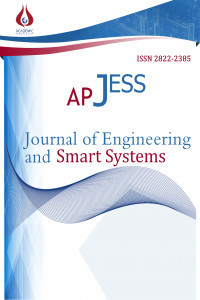Marin biyokütlenin hidrotermal sıvılaştırılması: Entegre bir proses
Marine Biomass, Hydrothermal Liquefaction, Supercritical CO2, Supercritical Water Hydrolysis, Reducing Sugar
Hydrothermal Liquefaction of Marine Biomass: An Integrated Process
Marine Biomass, Hydrothermal Liquefaction, Supercritical CO2, Supercritical Water Hydrolysis, reduced sugar,
___
- [1] Novo L.P., Gurgel L.V.A., Marabezi K., Curvelo A.A.S. 2011. Delignification of sugarcane bagasse using glycerol–water mixtures to produce pulps for saccharification. Bioresour. Technol. 102(21): 10040-10046.
- [2] Boopathy R. 1998. Biological treatment of swine waste using anaerobic baffled reactors. Bioresour. Technol. 64(1): 1-6.
- [3] Sasaki M., Fang Z., Fukushima Y., Adschiri T., Arai K. 2000. Dissolution and hydrolysis of cellulose in subcritical and supercritical water. Indus.& Engineer. Chem. Research. 39(8): 2883-2890.
- [4] Von Sivers M., Zacchi G. 1995. A techno-economical comparison of three processes for the production of ethanol from pine, Bioresour. Technol. 51(1): 43-52.
- [5] Sun Y., Cheng J. 2002. Hydrolysis of lignocellulosic materials for ethanol production: A review. Bioresour. Technol. 83(1): 1-11.
- [6] Harkin J.M. 1969. Lignin and its uses.US Department of Agriculture, Forest Service, Forest Products Laboratory.
- [7] Khiari R., Mhenni M., Belgacem M., Mauret E. 2010. Chemical composition and pulping of date palm rachis and Posidonia oceanica–A comparison with other wood and non-wood fibre sources. Bioresour. Technol. 101(2): 775-780.
- [8] Kumar P., Barrett D.M., Delwiche M.J., Stroeve P. 2009. Methods for pretreatment of lignocellulosic biomass for efficient hydrolysis and biofuel production. Indus. & Engineer. Chem. Research. 48(8): 3713-3729.
- [9] Fang Z., Sato T., Smith Jr R.L., Inomata, H., Arai K., Kozinski J.A. 2008. Reaction chemistry and phase behavior of lignin in high-temperature and supercritical water. Bioresour. Technol. 99(9): 3424-3430.
- [10] Pilavtepe M., Yesil-Celiktas O. 2013. Mathematical modeling and mass transfer considerations in supercritical fluid extraction of Posidonia oceanica residue, Journal of Supercritical Fluids. 82: 244-250.
- [11] Miller G.L. 1959. Use of dinitrosalicylic acid reagent for determination of reducing sugar. Analytic.Chemis. 31(3): 426-428.
- [12] Kumar S. 2010. Hydrothermal treatment for biofuels: lignocellulosic biomass to bioethanol, biocrude, and biochar. Electronic Thesis and Dissertations, Auburn University.
- [13] Sasaki M., Adschiri T., Arai K. 2004. Kinetics of cellulose conversion at 25 MPa in sub- and supercritical water. AIChE Journal. 50(1): 192-202.
- [14] Sasaki M., Iwasaki K., Hamaya T., Adschiri T., Arai K. 2001. Super-rapid enzymatic hydrolysis of cellulose with supercritical water solubilisation pretreatment. Japanese Journal of Polymer Sci. Technol. 58(10): 527-532.
- [15] Sreenath H.K., Koegel R.G., Moldes A.B., Jeffries T.W., Straub R.J. 1999. Enzymic saccharification of alfalfa fibre after liquid hot water pretreatment. Process Biochemis. 35(1): 33-41.
- [16] Pasquini D., Pimenta M.T.B., Ferreira L.H., Curvelo A.A.S. 2005. Extraction of lignin from sugar cane bagasse and Pinustaeda wood chips using ethanol–water mixtures and carbon dioxide at high pressures. Journal of Supercritical Fluids. 36(1): 31-39.
- [17] Pilavtepe M., Sargin S., Celiktas M.S., Yesil-Celiktas O. 2012. An integrated process for conversion of Zostera marina residues to bioethanol. Journal of Supercritical Fluids. 68: 117-122.
- [18] Kilambi S., Kadam K.L. 2012. Production of fermentable sugars and lignin from biomass using supercritical fluids. WO Patent. 2,011,091,044.
- Yayın Aralığı: Yılda 3 Sayı
- Başlangıç: 2022
- Yayıncı: Akademik Perspektif Derneği
Transfer Hatlarında Geçici Durum Çıktı Analizi: Analitik Metod Kullanımı
Görkem SARIYER, Mehmet Cemali DİNÇER
Alüminyum Cürufundan Çelik Endüstrisi için Flaks Üretimi
Nedim SÖZBİR, Asude ATEŞ, Mustafa AKÇİL
Orman Biokütlesinin Atmosfere Katkısı
Marin biyokütlenin hidrotermal sıvılaştırılması: Entegre bir proses
